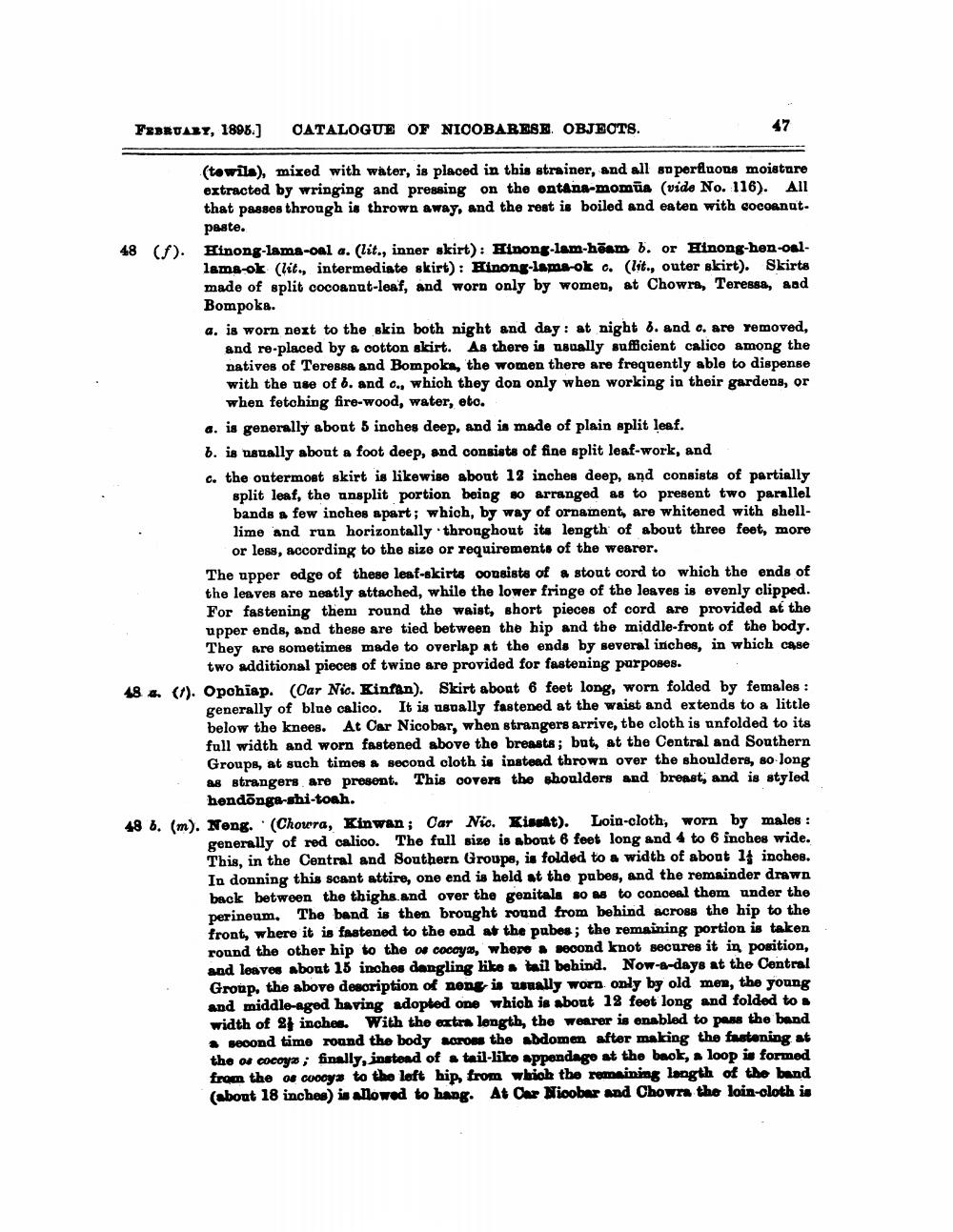________________
FEBRUARY, 1896.]
CATALOGUE OF NICOBARESE. OBJECTS.
47
(towila), mixed with water, is placed in this strainer, and all so perfinons moisture extracted by wringing and pressing on the ontana-momūs (vide No. 116). All that passes throngh is thrown away, and the rest is boiled and eaten with coconut
paste. 48 (S). Hinong-lama-oal a. (lit., inner skirt): Hinong-lam-hoam b. or Hinong-hen-osl.
lama-ok (lit., intermediate skirt): Hinong-lame-ok c. (lit., outer skirt). Skirts made of split cocoanut-leaf, and worn only by women, at Chowra, Teressa, and Bompoka. a. is worn next to the skin both night and day : at night 6. and c. are removed,
and re-placed by & cotton skirt. As there is usually sufficient calico among the natives of Teressa and Bompoka, the women there are frequently able to dispense with the use of 6. and c., which they don only when working in their gardens, or
when fetching fire-wood, water, eto. a. is generally about 5 inches deep, and is made of plain split leaf. 6. is usually about a foot deep, and consists of fine split leaf-work, and c. the outermost skirt is likewise about 13 inches deep, and consists of partially
split leaf, the unsplit portion being so arranged as to present two parallel bands a few inches apart; which, by way of ornament, are whitened with shelllime and run horizontally throughout its length of about three feet, more
or less, according to the size or requirements of the wearer. The upper edge of these leaf-skirts consists of a stoat cord to which the ends of the leaves are neatly attached, while the lower fringe of the leaves is evenly clipped. For fastening them round the waist, short pieces of cord are provided at the upper ends, and these are tied between the hip and the middle-front of the body. They are sometimes made to overlap at the ends by several inches, in which case
two additional pieces of twine are provided for fastening purposes. 48 4. (). Opohiap. (Oar Nio. Kinfan). Skirt about 6 feet long, worn folded by females :
generally of blue calico. It is usually fastened at the waist and extends to a little below the knoes. At Car Nicobar, when strangers arrive, tbe cloth is unfolded to its full width and worn fastened above the breasts; but at the Central and Southern Groups, at such times a second cloth is instead thrown over the shoulders, so long as strangers are present. This covers the shoulders and bronst, and is styled
hendõnga-shi-tosh. 48 6. (m). Neng. (Chowra, Kinwan; Car Nic. Kissat). Loin-cloth, worn by males :
generally of red calico. The full size is about 6 feet long and 4 to 6 inches wide. This, in the Central and Southern Groupe, is folded to a width of about 14 inches. In donning this scant attire, one end is held at the pabes, and the remainder drawn back between the thighs and over the genitals so as to conceal them under the perineum, The band is then bronght round from behind across the hip to the front, where it is fastened to the end at the pabes; the remaining portion is taken round the other hip to the o cocoy, where second knot secures it in position, and leaves about 18 inches dangling liko tail behind. Now-a-days at the Central Group, the above description of nong is usually worn only by old men, the young and middle-aged having adopted one which is about 18 feet long and folded to width of 2 inches. With the extra length, the wearer is enabled to pass the band
second time round the body across the abdomen after making the fastening at the ou cocoya; finally, instead of tail-like appendage at the book, loop is formed from the os coooy» to the left hip, from which the remaining langth of the band (about 18 inchos) is allowed to hang. At Car Nioober and Chowra the loin-oloth is




